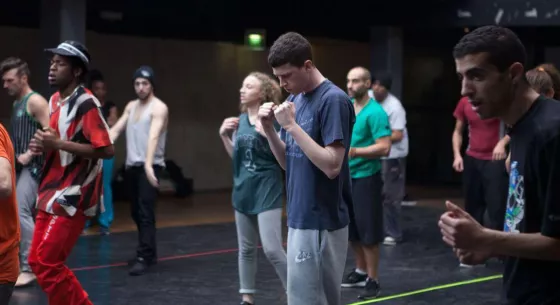The wonders of choreographer Merzouki and his wordplay
I first heard of Mourad Merzouki, and first laid eyes on his choreography, in 2002. I had just started working as an agent for dance in New York City, and one of my colleagues at the agency was raving about a fantastic hip-hop company she had seen up at Jacob’s Pillow the previous summer.
Although Compagnie Käfig had been gaining acclaim in their home base of Lyon, France, and on European tours since 1996, the summer of 2001 marked their U.S. debut. The work they presented at the Pillow was called “Ten Versions,” referring to 10 different segments in which 10 dancers displayed unique styles and specialties in the hip-hop tradition that honored the soloist. In French, that title was Dix Versions, a play on the word “diversions.” Later, as I learned about and saw more of Merzouki’s work, I noticed that wordplay cropped up again, alongside some incredible choreographic exploration combining the roots of hip-hop with more formal contemporary dance approaches such as unison work and counterpoint and abstract narrative.
The company at the time was made up of dancers of Algerian and North African descent (Merzouki’s own heritage), but since the beginning, the company’s mission has been to bring people and dancers together from all over the world and erase their differences through dance. The excitement in Merzouki’s work often comes from the unexpected collaborations, or collisions of ideas. His background includes study in martial arts, and so Boxe Boxe put boxing moves in a ring with the Debussy String Quartet.
His collaboration with South African choreographer Jay Prather mixed hip-hop and traditional Zulu dances in Pas a Pas. He played with calligraphy and movement in Corps est Graphique—meaning “the body is graphic,” or, “choreography” if you twist the French sounds just so.
Two works created for an all-Brazilian group of dancers Agwa (2008) and Correria (2010) marked Compagnie Käfig’s Northrop debut in 2015. There’s that word play again—the title combines the words for “running” and “water”—though not a drop was spilled as the dancers flipped, spun and tossed hundreds of cups about the stage in that truly delightful work.
On Nov 3, Compagnie Käfig will present Pixel. Merzouki’s imagination draws a bit on his own circus training, but more heavily on his fascination with the digital art of Adrien M/Claire B. Choreographing the light projections to accompany the movement of the dancers, Pixel’s technical virtuosity matches the physical prowess of the dancers and plunges us into an exciting new world. I do hope you’ll join us!


